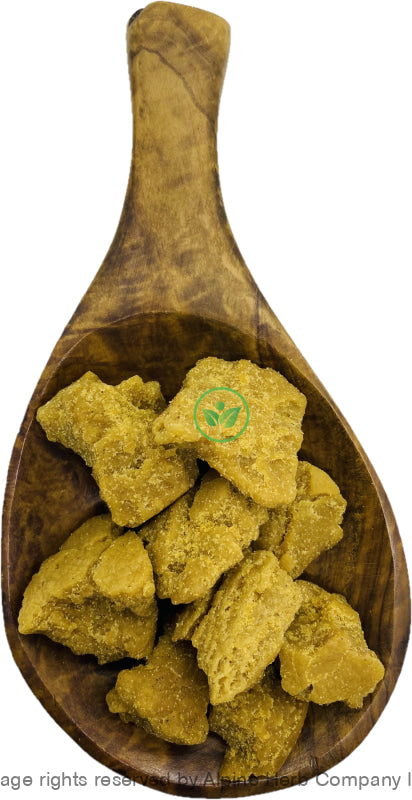Asafoetida Pieces Alpine Herb Company Inc.
$ 15,49 $ 9,29
Botanical Name: Ferula assa-foetida
Common Name:
- English: Asafoetida
- Ayurvedic: Hinguka, Jatuka, Baahlika, Hingu
- Sanskrit: Sahasravedhi
- Unani: Hing, Hitleet
- Also, known as: Asfoetida, Raamattha, Ramaha, Vedhi, Hin, Vagharni, Hingda, Ingu, Baahilka, Inguva, Hengu, Eng, Hira, Kayam, Perungayam, Devil’s dung, A wei duiwelsdrek, Férule persique, Ase fétide, Stinkasant, Teufelsdreck, Assafetida, Agi, Anghuzeh, Asafetida, Dyvelstrack
Habitat: Native to Afghanistan, Persia, India
Origin: India
Harvested: Wild
Parts Used: Resin
General Information:
Asafoetida, also very popular as HING, is an Indian spice used for flavoring the food and in herbal medicines for the treatment of the digestive system. However, flavoring food is not the main concern of Hing spice.
Asafoetida is a resin collected after making an incision at the upper part of taproot of more than five years old plants, just before flowering, whole process repeated many times, after 1 or 2 days or after a few weeks when it gets hardened from the asafetida plant.
Ferula assa-foetida occurs in Western Iran from Eastern Iran to Pakistan and India and in Afghanistan. These are the best-known sources of culinary Asafoetida but there are several other plants of this species that are the source of resinous gums used in perfumes, incenses, and traditional medicine.
Asafoetida is an important spice in Middle Eastern and South Asian cuisines and is widely used, especially in India for flavor.
How to use:
As a spice
Precautions:
You should consult with a qualified healthcare practitioner before using any herbal products, particularly if you are pregnant, nursing, or on any medications.
All information on this website is for educational purpose ONLY
This information has not been evaluated by Health Canada.
This information is not intended to diagnose, treat, cure, or prevent any disease.
| Unit Size | 100g, 200g, 400g, 1kg |
|---|
Prompt shipping and expert packing
Thanks to our longstanding association with UPS FedEx DHL as well as other leading global carriers, we can offer a variety shipping options. Our warehouse staff is highly trained and will be able to pack your goods in accordance with our precise and exact specifications. Your items will go through an exhaustive examination before they will be securely packaged before being delivered. We ship to hundreds of thousands of customers daily in different countries. This is a sign of our determination to become the largest online retailer worldwide. Warehouses and distribution centers are located throughout Europe as well as in the USA.
Note that orders containing multiple items are processed according to the particular item.
We will thoroughly inspect all items ordered before shipping. Most orders are shipped within 48 hours. The delivery time will be between 3 and 7 working days.
Returns
The stock market is always changing. It's not entirely managed by us since we're involved with several entities, including the factory and the storage. Therefore, the actual inventory could fluctuate at any moment. Please be aware that it is possible that your order could be out of stock after you've placed your order.
Our policy lasts for 30 days. If it's been more than 30 days since the date you purchased your item We're sorry to say that we can't offer you a full exchange or refund.
You can only return a product if it is unused and still in the same state as when you received it. The item should be in the original packaging.
Related products
Spices Whole
Spices Whole
Spices Whole
Spices Whole
Spices Whole
Spices Whole
Spices Whole
Spices Whole
Spices Whole
Spices Whole
Spices Whole
Herb Whole
Spices Whole
Spices Whole
Spices Whole
Spices Whole
Spices Whole
Spices Whole
Spices Whole
Spices Whole
Spices Whole
Spices Whole
Spices Whole
Spices Whole
Spices Whole
Spices Whole
Spices Whole
Spices Whole
Spices Whole
Spices Whole


































